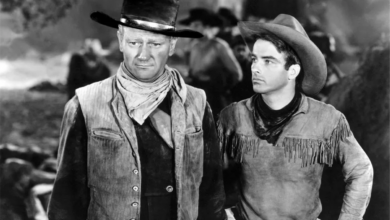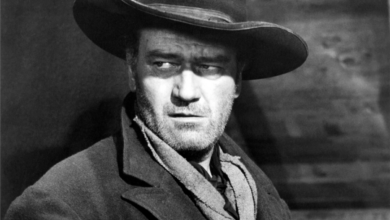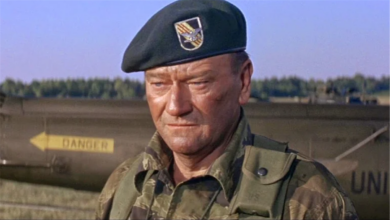The Groundbreaking John Wayne Western You’ve Likely Never Seen

There’s a reason John Wayne is thought of as the quintessential cowboy, from his breakthrough role in “Stagecoach” (1939) to his final movie, “The Shootist” (1976). Starring in 142 motion pictures spanning six decades, John Wayne’s movies have made him synonymous with the Old West. His Westerns embody the frontier history of the United States, and he’s often starred in many of the best Westerns of all time alongside the likes of James Stewart, Robert Mitchum, and Kirk Douglas. My personal favorite, “True Grit,” saw him take home the Academy Award for Best Actor in 1969 for the now-iconic role of U.S. Marshal Rooster Cogburn. But there’s one revolutionary John Wayne movie you’ve probably never seen.
“The Big Trail” was released in 1930 and starred Wayne as Breck Coleman, a young trapper looking to avenge the death of his friend while scouting a caravan on the Oregon Trail. It was Wayne’s first leading role, with director Raoul Walsh first spotting him on set as a prop man moving heavy furniture. Eventually, Walsh cast him in the lead role, and the rest is history. But while “The Big Trail” was seen as a critical success, it was a box office bomb.
That meant very few Western fans even saw the movie, despite its groundbreaking visuals.
A New Widescreen Format Proved Beautiful But Costly

“The Big Trail” used a revolutionary film process — it was shot simultaneously on standard 35mm film as well as the early widescreen format, 70mm Grandeur. This meant there were two different versions of the same film, with the widescreen format creating more epic, sweeping shots while 35mm allowed for more intimate closeups.
Screenwriter Hal Everts said of the 70mm format: “one may portray a couple making love in the foreground yet so universal is the focus that a cabin on a mountainside, miles away, shows up with microscopic distinctness.”
The camera angles and cinematography are very different in both cases, with preferential treatment given to the 70mm version. Each version was edited independently, too, with some shots appearing in one version and not the other. The 35mm version of “The Big Trail” is 108 minutes, while the 70mm version is longer, at 122 minutes.
Ultimately though, the world wasn’t ready for 70mm — and neither were theaters. Unwilling to invest in new widescreen technology, theaters failed to show “The Big Trail,” which went all-in on its widescreen release.
Big Trail, Bigger Production

Widescreen wasn’t the only thing to make “The Big Trail” so innovative — it also pushed the boundaries of size and scale when it came to the film’s production.
“The number of actors used was staggering,” said Marilyn Ann Moss in her book, “Raoul Walsh: The True Adventures of Hollywood’s Legendary Director.” “Not to mention the extras, even animals needed for the shoot: 20,000 extras, 1,800 head of cattle, 1,400 horses, and 500 head of buffalo traveled with the production.”
Production lasted several months, between April 20 and August 20, 1930, and was filmed in seven different states. It was undoubtedly one of the most ambitious Westerns ever made. “Walsh used 725 Native American [sic] extras from five separate tribes and almost enough props to warrant the movie documentary status, including the 185 wagons,” explained Moss.
“The production crew was equally impressive: a staff of 293 principal actors and 22 cameramen. Then there were the 12 Indian guides and the 123 baggage trains that trekked over 4,300 miles in the seven states used for locations. Also brought along were the picture’s 700 barnyard animals, including dogs, pigs, and chickens.”
Additionally, Walsh is said to have researched every aspect of the film to ensure authenticity — even the food supplies carried by the caravan were said to be historically accurate.
A Box Office Bust But a Critical Success

Only two theaters in the U.S. were capable of screening the 70mm version of “The Big Trail,” and with a hefty budget of $1.25 million the film turned out to be a box office catastrophe.
Even Fox Film Corporation’s promise to help theaters with widescreen projection failed to entice them to invest. And so, one of John Wayne’s biggest, most groundbreaking movies went relatively unseen, even though the critics went crazy for it.
“Often the scenes in ‘The Big Trail’ […] cause one to marvel at their naturalness and beauty,” wrote Mordaunt Hall in The New York Times in 1930. “It has an Indian [sic] attack on the camp of the white folks supposed to be journeying from the banks of the Missouri to the golden West a century ago, and while there have been many such conflicts shown in pictures, nothing to equal this particular Indian [sic] onslaught has been filmed.”
“The Big Trail” currently holds a 100% rating on Rotten Tomatoes. It was even deemed “culturally, historically, or aesthetically significant” and inducted into the United States Library of Congress in 2006.
But despite the film’s reception, it remains widely unseen, becoming one of the most underrated Westerns of all time.





